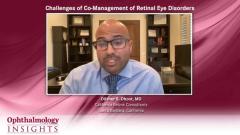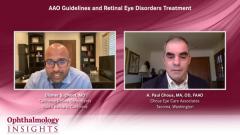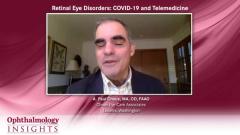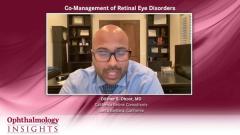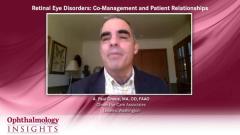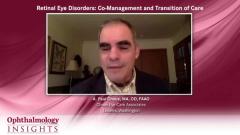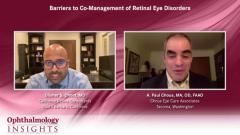
Retinal Eye Disorders: Co-Management Transition of Care
Dilsher S. Dhoot, MD, and A. Paul Chous, MA, OD, FAAO, discuss the transition of care from ophthalmologist to optometrist once a patient has completed active treatment for retinal eye disease.
Episodes in this series

A. Paul Chous, MA, OD, FAAO: Who’s responsible for follow-up after retinal treatments after anti-VEGF [anti–vascular endothelial growth factor]? Is there a global period for anti-VEGF injections? Is it you’re done and you’re out?
Dilsher S. Dhoot, MD:There’s not a global period when it comes to payers, to post anti-VEGF injections. There are global periods for lasers, which can range from 10 to 90 days. There’s certainly global for surgery vitrectomy, for example, or a buckle 90 days. Generally, the retina specialist is responsible for their patient following a procedure or a surgery. We schedule those visits. If a patient has an issue—if they’re in a remote area—they may end up seeing an optometrist. First, if they’re having issues with the pressuring, sometimes we’ll comanage it. That may be an example of comanagement when it comes to postsurgical patients. We’ll comanage pressure issues because it can be a steroid response or a spike in pressure after you’ve gassed up the eye. If patients live far away, we often will lean on optometry for help with that, but the surgeon is responsible for patients in the follow-up period.
A. Paul Chous, MA, OD, FAAO: That’s your purview, not our purview, but I know that my colleagues in optometry are happy to help in any way that we’re asked to. We want you to do what you’re great at.
Dilsher S. Dhoot, MD:Definitely. Can you talk about the transition of care from ophthalmology to optometry? Once a patient has completed active treatment, how do you like to see that? Does that occur? Tell me more about that.
A. Paul Chous, MA, OD, FAAO: Once a patient has completed their treatment cycle for whatever pathology they might have, it’s incumbent on us in optometry to continue to follow the patient for reactivation of the disease. Looking at the fellow eye, for instance, in a patient who has only 1 eye that’s been treated, we monitor them closely to see if a lot of these is obviously become bilateral. That’s part of what we can do. How often should the patient see the retina specialist once a treatment regimen has been completed? My experience has been with things like retinal tear and detachment. The retina specialist might see the patient in a year and say, “You don’t have to come back and see me anymore.” That’s totally different from patients who have wet AMD [age-related macular degeneration] or DME [diabetic macular edema] or ME [macular edema] secondary to venous occlusion and the like. What are your thoughts?
Dilsher S. Dhoot, MD:Those are all good points. I agree. There are conditions for which patients are probably going to on be this schedule for the rest of their lives, like macular degeneration. Even if you’ve stabilized that patient or the CMV [cytomegalovirus] appears inactive, and you’ve decided to take a holiday off the anti-VEGFs—in some patients we do that, especially if they insist; many patients receive just quarterly injections, but if you did take a holiday and it appears inactive, I think—they would still follow up at some period of time because it can reactivate.
There are other conditions for which they’re essentially cured of the condition if they’re lucky, such as vitro macular attraction. They may have an EMT [epithelial–mesenchymal transition], and it spontaneously releases, and you’re done with that patient. It’s not going to occur. You’re not going to have any further conditions. Maybe they’ll develop an ERM [epiretinal membrane], but they can be sent back. For those patients, a retina specialist will see on a pro re nata basis, but it’s always important to have good correspondence and communication with your optometry colleague and say, “Everything looks fine. We’re going to send them back to you. If there are any issues, we’re here.” Usually, my transfer of care will be in the form of a letter, and I’ll make it pretty clear that the condition I’m treating looks very stable. I suspect that the patient will be fine, but the door is always open if there’s an issue. It seems to have worked out so far.
A. Paul Chous, MA, OD, FAAO: Specifying whether they call it the surveillance interval is helpful. If I want to see this patient once a year, letting us know that is going to be really helpful. The same is true with respect to glaucoma specialists and even cataract surgeons who want to follow patients up for an inoperative complication that the patient experienced. Knowing when you want to see the patient back is helpful.
TRANSCRIPT EDITED FOR CLARITY
Newsletter
Don’t miss out—get Ophthalmology Times updates on the latest clinical advancements and expert interviews, straight to your inbox.


